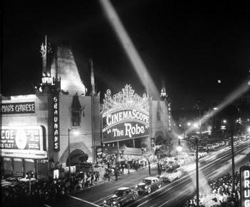Lectures
Lecture 5

John Steinbeck and Tortilla Flat
By the early 1900s, California was taking shape. Geographically, of course, it had always been there. But it was beginning to acquire a voice and identity of its own, as were its various regions. John Steinbeck was vital to this process.
Steinbeck was born in Salinas; Central California is a setting in many of his fifteen novels. He is best known, of course, for The Grapes of Wrath, the epic novel in which the Joad family journeys west from the Dust Bowl of Oklahoma to California, looking for a new beginning. As they see California spreading out endlessly before them for the first time from the top of the Tehachapi Pass, opportunity seems as vast as the state itself. But their dreams are dashed against the cold reality of Depression-era California, in which they become nothing more than moving parts in the dehumanizing machine of factory farming. In this novel, Steinbeck, like others (notably, the poet Robinson Jeffers), potrayed California as a place where the American Dream would meet its final and bitter end. In other of his novels, such as Tortilla Flat, the outlook is not so bleak.
Steinbeck was born on February 27, 1902. His father, John Ernst Steinbeck, Sr., was treasurer of Monterey County, and his mother, Olive, taught in the Salinas Valley public schools. Steinbeck grew up in a house where there were lots of books, and he wrote stories from an early age. In high school, he was on the track and basketball teams, and also worked on the school paper, as well as being class president. During his holidays, he worked as a laborer on farms in the area. He took a year away from education between high school and college and worked as an assistant chemist in a sugar beet factory.
In 1919, he started at Stanford University, but his attendance there was sporadic and he left after 5 years without taking a degree. He published several short stories in Stanford publications, and took a number of writing classes. He was interested in becoming a writer, and not so interested in attending college. He would take whole semesters off to work on ranches and road crews; he also worked for a time as a night chemist in the sugar beet factory where he'd previously worked.
In 1926, he went to New York to find a publisher; he failed. He worked there as a reporter and in various jobs as a laborer, and finally left New York as a deckhand on a ship going to the Panama Canal. He was relieved to be back in California, and was bitter about his New York experience. He still wanted to be a writer, and moved from odd job to odd job, from Lake Tahoe to Pacific Grove to Eagle Rock in Los Angeles, for several years before he was able to make enough money from his writing to support himself. He had two novels published, but they were financially unsuccessful. Tortilla Flat was the first book Steinbeck wrote which made him any money. He'd submitted it to eleven publishers before he found one who would print it.
Tortilla Flat was originally planned as a series of short stories based on events he'd seen himself or about which he'd been told by Susan Gregory, who'd lived in Monterey for years, and to whom the book is dedicated. It was on the best-seller lists for months, was produced as a stage play, and was made into a movie. It was banned in Ireland, and the Monterey Chamber of Commerce, fearing its effect on the tourist trade, attacked it as well, saying the book was a lie.
What they certainly objected to was the happy tone of the book, combined with the lack of morality of its characters. Lincoln R. Gibbs says,
It is not too strained an interpretation to read this book as a jolly satire of respectable society. Treat the average community as follows: Eliminate the institution of property; reduce marital fidelity to a minimum--or less; raise the per capita consumption of alcohol many degrees; instead of doing your exploitation legally and on a grand scale, do it by petty larceny and burglary; let your charities be matters of sporadic impulse; and spread over the whole a veneer of religion. You then have a parallel between the world of paisanos and the reputable community...There--in Tortilla Flat--but for the grace of God, goes Main Street.
In this novel, Steinbeck, like many other California writers, contrasts the Dream with the reality. But this novel is comic, rather than tragic, a satire rather than an expose.
If you'd like more information on any of the topics covered in this lecture, go to the Links page. Enjoy!
The information in this lecture is derived in part from the following sources:
~ Tetsumaro Hayashi, A Study Guide to Steinbeck
~ Robert Murray Davis, Steinbeck: A Collection of Critical Essays
~ E. W. Tedlock, Jr., and C. V. Wicker, Steinbeck and His Critics
